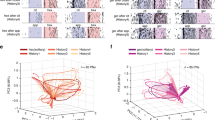Abstract.
We propose a neural mechanism for discrimination of different complex odors in the olfactory cortex based on the dynamical encoding scheme. Both constituent molecules of the odor and their mixing ratios are encoded simultaneously into a spatiotemporal activity pattern (limit cycle attractor) in the olfactory bulb [Hoshino O, Kashimori Y, Kambara T (1998) Biol Cybern 79:109–120]. We present a functional model of the olfactory cortex consisting of some dynamical mapping modules. Each dynamical map is represented by itinerancy among the limit cycle attractors. When a temporal sequence of spatial activity patterns corresponding to a complex odor is injected from the bulb to the network of the olfactory cortex, the neural activity state of each mapping module is fixed to a relevant spatial pattern injected. Recognition of an odor is accomplished by a combination of firing patterns fixed in all the mapping modules. The stronger the response strength of the component, the earlier the component is recognized. The hierarchical discrimination of an odor is made by recognizing the components in order of decreasing response strengths.
Similar content being viewed by others
Author information
Authors and Affiliations
Additional information
Received: 28 November 1998 / Accepted in revised form: 17 December 1999
Rights and permissions
About this article
Cite this article
Oyamada, T., Kashimori, Y., Hoshino, O. et al. A neural mechanism of hierarchical discrimination of odors in the olfactory cortex based on spatiotemporal encoding of odor information. Biol Cybern 83, 21–33 (2000). https://doi.org/10.1007/s004229900139
Issue Date:
DOI: https://doi.org/10.1007/s004229900139




